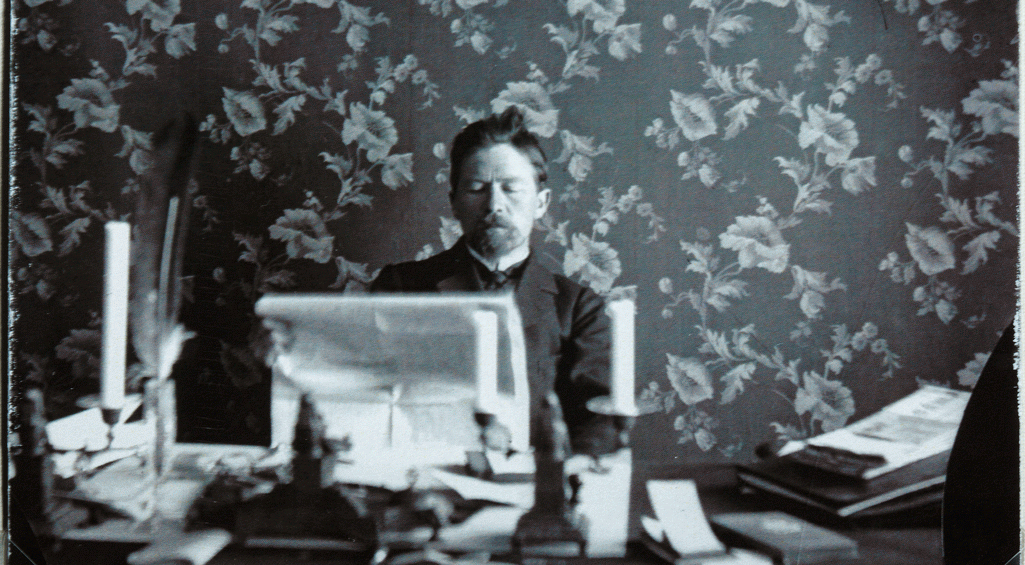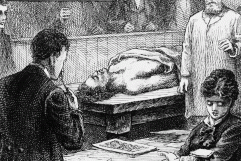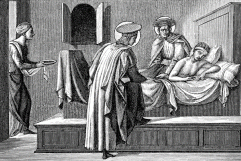
Doctors, writers and artists
Art has reflected the work of medical professionals in many sculptures, paintings and novels down the ages, from Egypt to 20th century films.
Artists have represented doctors in their creations for millennia. The first works are linked to the Greek myths and gods and semi-gods who practiced medicine such as Apollo, the god of healing, or the centaur Chiron, son of Cronus who taught his science to Asclepius, Apollo’s son. Asclepius was the one who gave his main emblem to medicine, representing it as a snake-entwined staff.
Egyptian mythology also had it doctors. Such as the famous Imhotep, who is represented in many sculptures, or Merit-Ptah, the first known woman dedicated to medicine between the 27th and the 25th centuries B.C. and who we see represented on a tomb in the necropolis of Saqqara, as recalled by Juan Frau in his book La imagen del médico en el arte y la literatura (The image of doctors in art and literature) (Casimiro, 2016). Later on, in the Middle Ages, when religion took over the entire artistic field, doctors were relegated to illuminated manuscripts or to the engravings in scientific tomes. All of them, except for Cosmas and Damian, Hermione of Ephesus or Cyril of Alexandria who, in addition to doctors were also Christian saints and martyrs.
We had to wait until the end of the Middle Ages to find paintings with scenes from everyday life where different professions were portrayed, including doctors. In the engravings from the 15th and 16th centuries, reproductions of anonymous doctors in different circumstances and attitudes could be found, such as the case of the engravings for the De officiis by Cicero, a work performed by Hans Weiditz in the year 1531.
From hero to villains
Chekhov, Baroja and Bulgakov poured their experiences as doctors into their novels, while Mann, Celine and Camus turned doctors into incredible leading or secondary characters
However, the profession did not fully enter literature until the 19th century, when novels became consolidated. The doctor is a hero, a man of action who represents scientific progress. This is how Tertius Lydgate is portrayed, the main character from Middlemarch, a novel published in instalments between 1871 and 1872, written by George Eliot. The characters created by Flaubert, Chekhov, Zola or Stevenson were also honest and noble. The so-called spurred-doctors deserve a mention, present in realistic novels from the 19th century. They were country doctors who appear in many engravings, heroes who star in novels such as Balzac’s Le médecin de champagne. And it is not surprising that many of these doctors were also writers who felt the need to pass on their experiences, such as Anton Chekhov and Felipe Trigo, or Pio Braoja and Mikhail Bulgakov in the 20th century. Other doctors who were famous in literature, showing a more intellectual, existentialist and disenchanted side were Ferdinand Bardamu by Céline and Bernard Rieux, the narrator of The Plague, by Albert Camus.
But the doctor was not always the hero in literature. In the Middle Ages, doctors were represented by their ineptitude and miserliness in the scornful ballads from Galician-Portuguese lyric poems; and in the 16th and 17th centuries Tirso de Molina, Lope de Vega, Góngora, Cervantes or Quevedo highlighted this satirical view of doctors. Baltazar Gracián stated that nobody could speak well or badly of doctors, “neither before putting yourself in their hands, because you have no prior experience: nor after, because you no longer have any life.” The Commedia dell’Arte also laughed at doctors with figures such as Balanzone or Baloardo, who were characterised for their pedantic natures and verbosity.
On the other hand, in relation to medicine, there are two diseases that have occupied hundreds of pages of novels: syphilis and tuberculosis, both associated to libertine and marginal contexts. The latter developed an aura of mystery and fascination in the cultural elite according to Juan Frau and reached its peak in Der Zauberberg (The Magic Mountain), by Thomas Mann.
Doctors and friends
Painters also knew how to reflect the world of medicine and its main characters. From the 16th century onwards, we see the work by Bosch: The Extraction of the Stone of Madness. Centuries later we find Pablo Picasso and his oil painting Science and Charity, from 1897, or the Self-portrait with doctor Arrieta (1820) by Francisco Goya. Sorolla, Rembrandt and Monet also painted doctors, friends and acquaintances on their canvasses. Toulouse-Lautrec painted two doctors: Henri Bourges and Gaston Bonnefoy in his series of portraits on pasteboard in 1891. Vincent Van Gogh painted his famous portrait of Paul Gachet during the weeks prior to his death in the summer of 1890. Gachet was both doctor and friend of painters such as Renoir, Cézanne, Pissarro or Monet.
With the evolution of the media, doctors have continued to be present on both the small and the large screen with mythical films such as Doctor Zhivago, based on a novel by Boris Pasternak, published in 1957 in Italy and in 1988 in the former Soviet Union and classic series such as M*A*S*H.
Medicine on the screen
1. In 1995, the film producer and director Wolfgang Petersen premiered ‘Outbreak’, starring Dustin Hoffman, Rene Russo and Morgan Freeman. It tells the story of the arrival in the USA of a mortal virus called ‘Motaba’ from Africa, which propagates across the entire country. Robin Cook, the author of the novel on which ‘Outbreak’ was based had been inspired by the hemorrhagic fever viruses, such as dengue or Ebola. The latter devastated Africa in 2014 and reached Spain in October of the same year.
2. ‘M*A*S*H’ is perhaps one of the most popular television series. In 1970, it was premiered as a film with Donald Sutherland, Elliott Gould and Robert Duvall and it was based on a book of the same name, published in 1968 and written by three army doctors who had served in the Korean War. Some years later, Gene Reynolds successfully transferred it to the small screen, thanks to the professional nature of actors such as Alan Alda, Wayne Rogers and McLean Stevenson, as recalled by Carlos Aitor Yuste and Jon Arrizabalaga in their book ‘Eso no estaba en mi libro de Historia de la Medicina’ (‘This wasn’t in my History of Medicine book’) (Libros en el Bolsillo, 2020).
3. ‘House’, starring the British actor, Hugh Laurie was an international hit. Created by Paul Attanasio, it was based on a column called “Diagnosis” written by Doctor Lisa Sanders in The New York Times. Sanders used the atypical symptoms of a case to discover the disease and its remedy. Thanks to this series, Laurie became one of the best-known and best-paid actors of the time.



